[press release]
Royal Mail Reveals Special Stamps for Christmas 2020
- Royal Mail celebrates Christmas 2020 with a series of six stained-glass Nativity scenes
- The stamps showcase the extraordinary detail and craftmanship of this highly specialised decorative art, covering a range of eras, styles and technique
- Stained glass windows from the following churches are included in the set:
- St Andrew’s Church, East Lexham, Norfolk
- St Andrew’s Church, Coln Rogers, Gloucestershire
- Church of St James, Hollowell, Northamptonshire
- All Saints’ Parish Church, Otley, West Yorkshire
- St Columba’s Church, Topcliffe, North Yorkshire
- Christ Church, Coalville, Leicestershire
- The Nativity is a common subject in stained glass artistry and from the 13th Century onwards, scenes often focused on the relationship between the new-born infant Jesus and his mother, the Virgin Mary
- The techniques of making stained glass have hardly changed since the Middle Ages
- Help Royal Mail’s postmen and women deliver this year’s festive mail by posting early this Christmas and using the postcode
- The stamps are on sale from today (3 November). They will be available at www.royalmail.com/christmas2020, by phone on 03457 641 641 and 7,000 Post Offices across the UK. In addition, around 1,000 retailers will stock Christmas stamp booklets this year
Royal Mail has revealed its Christmas 2020 stamps featuring a series of six stained-glass Nativity scenes.
The stained-glass Nativity scenes showcase the extraordinary detail and craftmanship of this highly specialised decorative art, covering a range of eras, styles and technique.
Stained glass windows from the following churches are included in the set:
- St Andrew’s Church, East Lexham, Norfolk
- St Andrew’s Church, Coln Rogers, Gloucestershire
- Church of St James, Hollowell, Northamptonshire
- All Saints’ Parish Church, Otley, West Yorkshire
- St Columba’s Church, Topcliffe, North Yorkshire
- Christ Church, Coalville, Leicestershire
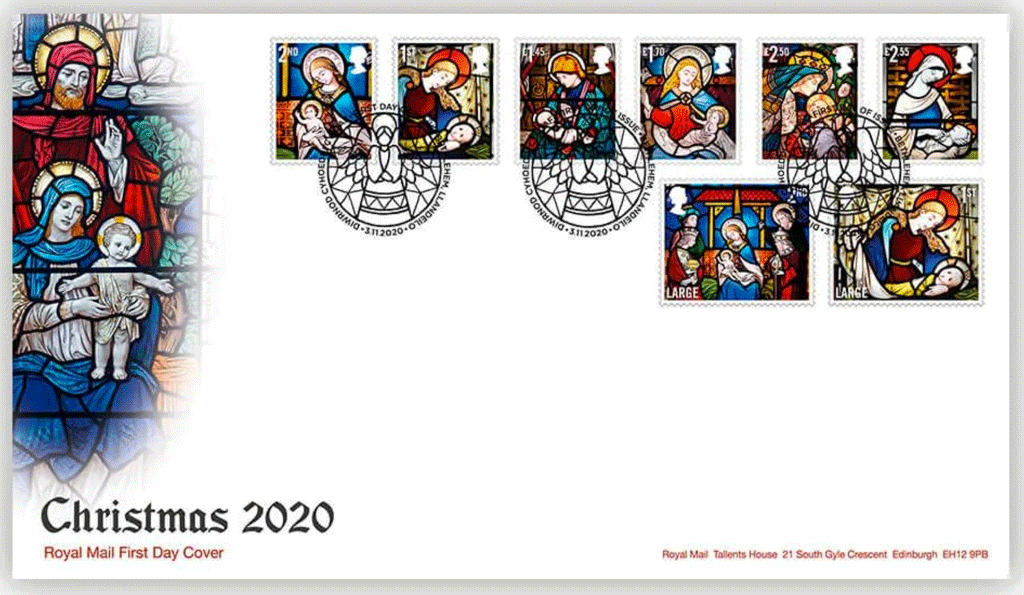
Traditionally, stained glass windows are assembled from pieces of coloured glass, held together with lead. The techniques of making stained glass have hardly changed since the Middle Ages.
The Nativity is a common subject in stained glass artistry and from the 13th century onwards, scenes often focused on the relationship between the new-born infant Jesus and his mother, the Virgin Mary.
Philip Parker, Royal Mail said: “Our beautiful Christmas stamps feature the Nativity as told through the artistry of different styles of stained-glass windows.”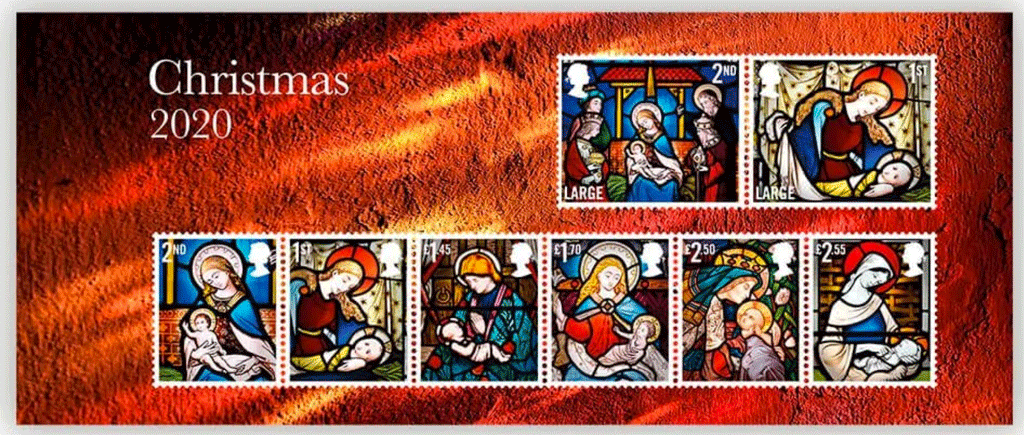
The origins of stained glass:
Stained glass originated in late antiquity. The Romans were the first to use coloured glass in windows, often set into plaster, stucco or metal frames. The oldest known examples of coloured window glass in England were excavated from the site of the former Anglo-Saxon monastery at Monkwearmouth Jarrow, Northumbria, which was founded in the 7th century.
By the 10th century, stained glass windows were being constructed with lead, which was more malleable and enabled greater versatility of design. Stained glass was a popular and expensive art form in the Middle Ages, used to decorate churches and other prestigious buildings. The translucent qualities of coloured glass meant that these windows projected coloured light into buildings, while illuminating colourful pictures.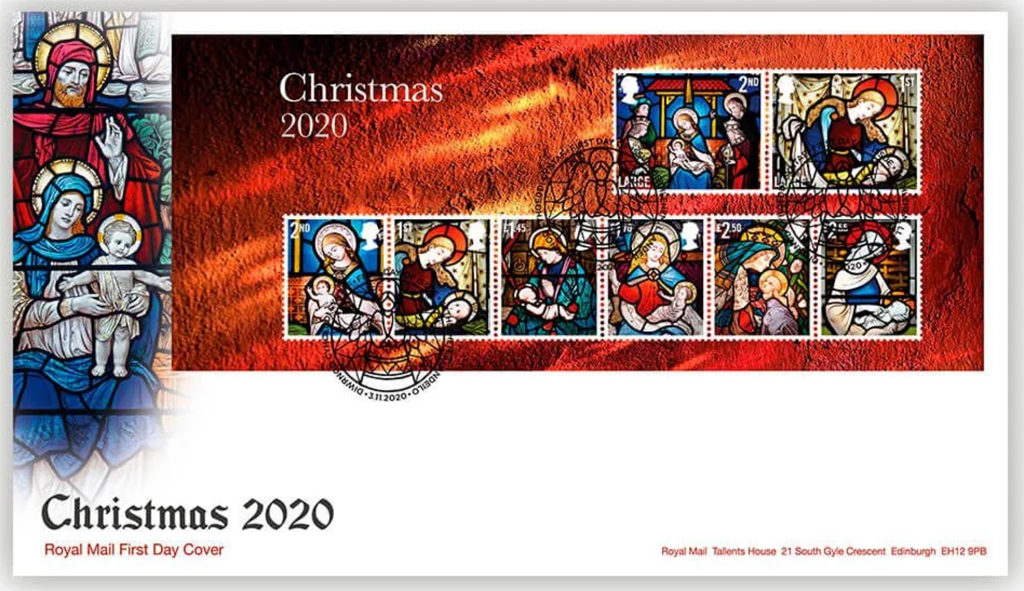
Panels of late 12th century stained glass survive at both Canterbury Cathedral and York Minster, but most surviving stained glass in the UK dates from the 13th century onwards. Following the Reformation in the 16th century, fewer religious stained glass windows were commissioned and, with a handful of exceptions, it was not until the 19th century that stained glass once again became a popular art form. Medieval windows provided inspiration for 19th century artists, who revived medieval techniques. Today, exquisite examples can be seen in the windows of our churches, town halls and other public and private buildings across the UK.
The stamps are on sale now and will be available at www.royalmail.com/christmas2020, by phone on 03457 641 641 and in 7,000 Post Offices across the UK. In addition, around 1,000 retailers will stock Christmas stamp books this year.
2nd Class stamp
Adoration of the Magi
Location: East window of St Andrew’s Church, East Lexham, Norfolk. This is an Anglican 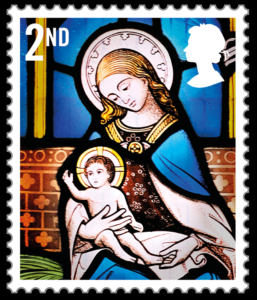 church, dedicated to Saint Andrew and is one of 124 existing round-tower churches in Norfolk. It is thought to date from circa 900AD and said to be one of the oldest in England.
church, dedicated to Saint Andrew and is one of 124 existing round-tower churches in Norfolk. It is thought to date from circa 900AD and said to be one of the oldest in England.
The Window: Mid-19th century stained glass, believed to have been made by Clayton & Bell in c.1859 – the designs adopted the gothic style of the 15th century in keeping with the perpendicular east window. The east window depicts scenes relating to Christ’s birth and death. The upper tier shows Christ carrying the Cross, The Crucifixion and Christ being taken down from the cross. The lower tier shows events related to Christ’s birth – the annunciation, Adoration of the Magi, and the presentation of Christ in the temple.
1st Class stamp
Virgin and Child
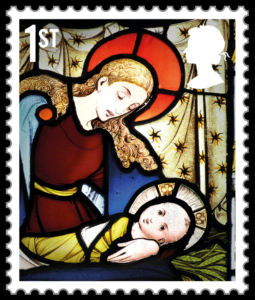 Location: St Andrew’s Church, Coln Rogers, Gloucestershire. This is an Anglican parish church and is dedicated to Saint Andrew. It is often described as being rather unique, as it has a Saxon nave and chancel which have survived almost intact. It dates to the mid-11th century.
Location: St Andrew’s Church, Coln Rogers, Gloucestershire. This is an Anglican parish church and is dedicated to Saint Andrew. It is often described as being rather unique, as it has a Saxon nave and chancel which have survived almost intact. It dates to the mid-11th century.
The Window: The three main lights of the east window of the church, dated c.1865 and made by the studio of Heaton, Butler and Bayne, focus on nativity scenes (including the Shepherds, Mary and Joseph with the Christ child and the three Magi). In the central light (from which this is a detail) Mary cradles the new-born Christ child.
£1.45 stamp
Virgin and Child
Location: Church of St James, Hollowell, Northamptonshire. The Church of St James was 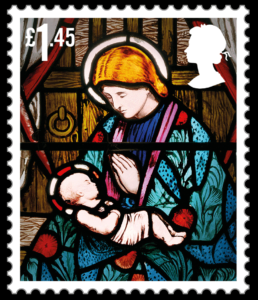 built in 1841 in the gothic style, and is known for its beautiful stained-glass windows in the eastern apse of the chancel, and the rose window above the west door.
built in 1841 in the gothic style, and is known for its beautiful stained-glass windows in the eastern apse of the chancel, and the rose window above the west door.
The Window: Chancel apse, south east window designed by Henry Holiday (1839-27) and made by J Powell & Sons, 1863. This is one of three lancet windows in the apse of the chancel. Each lancet window features a single narrative panel contained within a quatrefoil set against a background of decorative painted foliate grisaille (in the manner of the 13th century, decorated style). The north-eastern window depicts the Baptism of Christ, the central the Crucifixion, and the south-eastern (as pictured) shows the Virgin Mary and Christ child within the stable. The brightly coloured pieces of flashed ruby glass, and turquoise, blue, pink and purple tones demonstrates the wide variety and high-quality of the glass made at Powell’s glassworks.
£1.70 stamp
Virgin and Child
Location: All Saints Church, Otley, West Yorkshire. The first church building on the site was 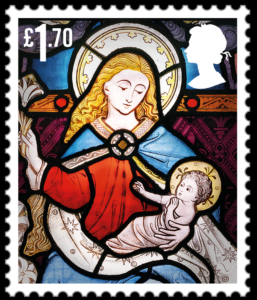 Anglo Saxon but only the foundations from this early church remain. A Norman church was built over them in the 11th century and this forms the present-day chancel. It was enlarged in about 1240. Further additions and modifications took place during later centuries, Including the installation of a number of stained-glass windows by various makers in the Victorian period.
Anglo Saxon but only the foundations from this early church remain. A Norman church was built over them in the 11th century and this forms the present-day chancel. It was enlarged in about 1240. Further additions and modifications took place during later centuries, Including the installation of a number of stained-glass windows by various makers in the Victorian period.
Window: This window is from a two-tier three light window in the South Transept of the church. The lower tier main lights show the Nativity with the Crucifixion in the upper tier above. It was manufactured by Clayton & Bell and installed in 1862. This image is the central scene of the Nativity. In the centre Mary is seated and holds the infant Jesus on her knee.
£2.50 stamp
Detail of the Holy Family
Location: St Columba’s Church, Topcliffe, North Yorkshire. St Columba’s is the parish 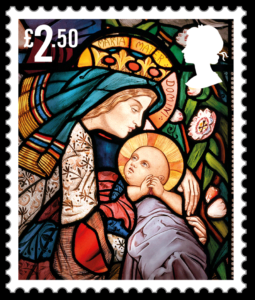 church of Topcliffe, near Thirskand the present building dates from the 13th century and was largely rebuilt by railway architect George T Andrews in 1885.
church of Topcliffe, near Thirskand the present building dates from the 13th century and was largely rebuilt by railway architect George T Andrews in 1885.
The Window: This well-known window is one of two windows located on the south side of the chancel of the church. The window is divided into three lights, showing three scenes in the life of Mary which also relate to the birth of Christ. On the left is the Annunciation, in the centre panel are Mary and her cousin and the panel on the right shows the Holy Family – Joseph, Mary and Jesus. This detail is from the scene of the Holy Family. It was designed by Michael Halliday and manufactured by Lavers & Barraud c.1860.
£2.55 stamp
Virgin and Child
Location: Christ Church, Coalville, Leicestershire. The church was built between 1836 and 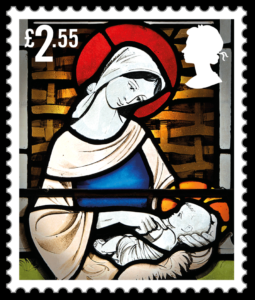 1838, with a west tower, large nave, transepts, chancel and vestry added later in 1936.
1838, with a west tower, large nave, transepts, chancel and vestry added later in 1936.
The Window: Whilst most of the glass is Victorian there are also three modern windows, which include the North chancel lancet window of the Nativity. The scene focuses on the virgin and child, with the ox and donkey watching over them (c. 1976). Harry Harvey (1922-2011) worked during the latter part of the twentieth-century producing stained-glass in a distinctive modern style. He died in 2011.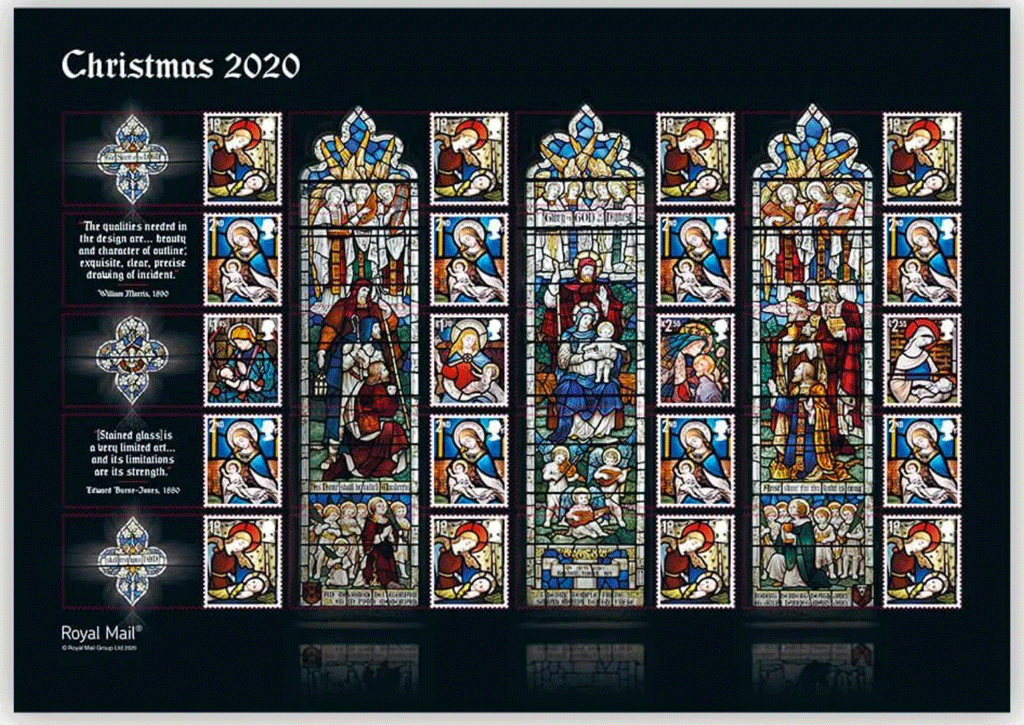




Thank you for this very informative article. As a descendant of Alfred Bell, the founder of Clayton & Bell, I am grateful that you give details of the artists whose work is featured in this year’s Christmas issue. My father was Michael Farrar Bell who as well as continuing the work of Clayton & Bell until the 1980s, was commissioned to design several postage stamps.